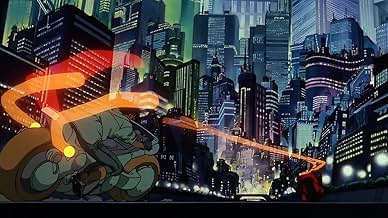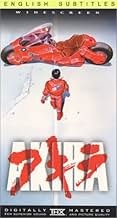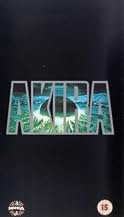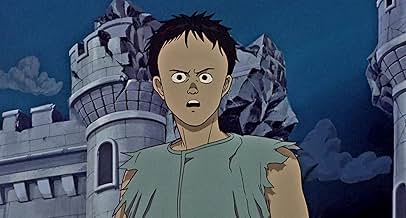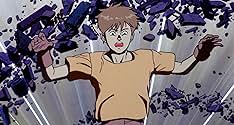एक गुप्त सैन्य परियोजना नियो-टोक्यो को खतरे में डालती है जब यह एक बाइकर गिरोह के सदस्य को एक उग्र मानसिक मनोरोगी में बदल देती है।एक गुप्त सैन्य परियोजना नियो-टोक्यो को खतरे में डालती है जब यह एक बाइकर गिरोह के सदस्य को एक उग्र मानसिक मनोरोगी में बदल देती है।एक गुप्त सैन्य परियोजना नियो-टोक्यो को खतरे में डालती है जब यह एक बाइकर गिरोह के सदस्य को एक उग्र मानसिक मनोरोगी में बदल देती है।
- पुरस्कार
- कुल 1 जीत
Mami Koyama
- Kei
- (वॉइस)
Tesshô Genda
- Ryû
- (वॉइस)
Hiroshi Ôtake
- Nezu
- (वॉइस)
Kôichi Kitamura
- Lady Miyako
- (वॉइस)
- …
Michihiro Ikemizu
- Inspector
- (वॉइस)
- …
Yuriko Fuchizaki
- Kaori
- (वॉइस)
Masaaki Ôkura
- Yamagata
- (वॉइस)
Tarô Arakawa
- Eiichi Watanabe
- (वॉइस)
- …
Takeshi Kusao
- Kai
- (वॉइस)
Kazumi Tanaka
- Army
- (वॉइस)
Masato Hirano
- Yûji Takeyama
- (वॉइस)
- …
फ़ीचर्ड समीक्षाएं
I was probably around 8, when I first saw Akira. It was my step dad who asked me if I was interested in watching this Japanese cartoon. I expected something like, my favorite children movies like The Lion King or The Land before Time.
Akira however, was something else. At the time I was to young to understand English, since it was a second language for me. But I remember what kind of an affect it had on me. It was brutal, it was hard, it was edgy. The drums and Neo Tokyo lights flew through my little body as butter, as I witnessed death, gore and sadistic killings. Something my pure and innocent eyes had never seen before. And yet I was strangely excited. I was never tough as a kid. I was a afraid of the dark and often had nightmares about all kinds of things. But Akira, despite it's mature nature, just had me in awe. When I finally re-saw it many years later, when I was an old teenager, I was still in awe.
Akira is simply a wonderful and entertaining sci-fi movie. It was what introduced me to anime, and innovation in a hole new way. If you want to start watching anime or see, what all the fuss is about, then Akira is a good place to start. Even though it's over 17 years old today, it is still a fantastic and visually stunning animation. Even if you don't appreciate animation you owe it to yourself, to check it out. It has spectacular action, motorcycle-chase-sequences, mad scientists and tons of blood and shooting.
8/10
Akira however, was something else. At the time I was to young to understand English, since it was a second language for me. But I remember what kind of an affect it had on me. It was brutal, it was hard, it was edgy. The drums and Neo Tokyo lights flew through my little body as butter, as I witnessed death, gore and sadistic killings. Something my pure and innocent eyes had never seen before. And yet I was strangely excited. I was never tough as a kid. I was a afraid of the dark and often had nightmares about all kinds of things. But Akira, despite it's mature nature, just had me in awe. When I finally re-saw it many years later, when I was an old teenager, I was still in awe.
Akira is simply a wonderful and entertaining sci-fi movie. It was what introduced me to anime, and innovation in a hole new way. If you want to start watching anime or see, what all the fuss is about, then Akira is a good place to start. Even though it's over 17 years old today, it is still a fantastic and visually stunning animation. Even if you don't appreciate animation you owe it to yourself, to check it out. It has spectacular action, motorcycle-chase-sequences, mad scientists and tons of blood and shooting.
8/10
10toji
Without a doubt the necessary injection of Manga culture Western audiences needed. Personal objections (or should I say appraisals) aside, Akira deconstructs the form of narrative and character development that we had all become accustomed to through Hollywood and produces a reasonably honest translation of Katsuhiro Otomo's Manga epic, with mass deletions of unnecessary characters and plot avenues. The story is complex enough to keep western audiences attention, yet simple enough to digest whilst taking in the wonderfull animation and excellent soundtrack (a collection of traditional Japanese instruments and modern day synthesised electronica that allow for elements of cinema to establish themselves for the audience) The conflict between the two main characters, Tetsuo and Kaneda is ultimately superceded by the films namesake, the mystery of the boy Akira, and as with very few films Hollywood produces it leaves it's more labour intensive thinking until the end. A delight to follow, with periods of intense action and thought provoking predictions of a neo society, one would like to think of the film as the pipe dream of one who predicted such tragic events as of September 11. Akira, whilst violent for the medium, is a lush metropolis of gang warfare, a psuedo examination into the possible, and a fantasy tale of elements long lost in modern cinema. A cool, entertaining piece littered with cult visions and awesome bikes.
*Stereotype: Akira is a gratuitous bloodbath.
Maybe, but it's also a hard-nosed societal critique. Gore fans get what they want, but they have some morality shoved down their throats, as well. Most people who hate this movie watch it with a predetermined mindset. . . It takes thought and patience to piece together its sophisticated story.
*Stereotype: Akira rocks!!
The animation equals or exceeds Disney's best, the music is awesome, and the characters are complex, but "Akira" has its flaws. Chunked together from a long pre-existing storyline and filled with gritty violence, "Akira" draws fanatics too bloodthirsty to appreciate its message, and scares away critics intelligent enough to understand it. It takes a very open mind to enjoy this movie.
All in all, be careful with this movie; it's not for everyone. Just ignore the hype on BOTH sides and judge for yourself. I recommend the subtitled version; the dub's voice actors suck and anyone who'll understand this movie is obviously smart enough to read.
Maybe, but it's also a hard-nosed societal critique. Gore fans get what they want, but they have some morality shoved down their throats, as well. Most people who hate this movie watch it with a predetermined mindset. . . It takes thought and patience to piece together its sophisticated story.
*Stereotype: Akira rocks!!
The animation equals or exceeds Disney's best, the music is awesome, and the characters are complex, but "Akira" has its flaws. Chunked together from a long pre-existing storyline and filled with gritty violence, "Akira" draws fanatics too bloodthirsty to appreciate its message, and scares away critics intelligent enough to understand it. It takes a very open mind to enjoy this movie.
All in all, be careful with this movie; it's not for everyone. Just ignore the hype on BOTH sides and judge for yourself. I recommend the subtitled version; the dub's voice actors suck and anyone who'll understand this movie is obviously smart enough to read.
Oozing with metaphorical messages and warnings, as relevant today as when it was first released, this apocalyptic take on a future world takes place in 2019, some years after an Armageddon event in Tokyo. Often as confusing as hell, a little bit all over the place at times, if you manage to make it to the end you may need to pause for thought to consider what you have witnessed, which can only be a good thing with the shallowness in so much of what we're served up these days. Definitely worth a visit.
'Akira' is an astonishingly influential film, easily as much so as cinema's touchstones Citizen Kane and Pulp Fiction. Its impact is made more difficult to judge, though, given that it was made more than sixteen years ago, and didn't make an initial impact outside of Japan. Oddly, this made its influence even more profound, benefiting from 'word of mouth' and the influx of cheap VHS at the end of the Eighties. It's also gained enough of a following to warrant being digitally remastered, at a cost of over US$1 million, as a 'Special Edition,' which I am basing these comments on.
Rather than suffering the humiliation of being advertised, Akira filtered, like a software virus, into the bedrooms of what would become Generation X. Hollywood began to sit up and pay attention after teens began abandoning the pap of the day like Last Action Hero, and started seeking out something different, dissident, and Akira finally had its audience. Japanese animation now has a firm presence in our media, and so many paths lead back to the cultural genesis of Akira. Finally, its role in the history of film was cemented with the release of last year's mega-hit, the Wachowski brothers' The Matrix. Without Akira, there is no Matrix, and with no Matrix, you have to wonder how very different Western cinema would be today.
So what is Akira? It's a Japanese animated film, an adaptation of 2,000 pages worth of graphic novel by Katsuhiro Otomo and set in the futuristic world of Neo-Tokyo. Rebuilt from the ashes of World War 3, it's a technological dream of neon, computers and soaring science, mated to the social nightmare of corrupt politicians, a rampant military and an oppressed working class. Add to this the rise of a powerful breed of psychics (or 'psionics') capable of various degrees of telepathy and telekinesis, and somehow linked to a top secret military project known as Akira, and Neo-Tokyo seems ready to explode. You can almost feel the heat, the sweat, and the grime, courtesy of the borderline-masochistic attention to detail in every frame of every scene of animation.
Akira is all about hyper-reality, which later became known as bullet time. Animation, and more importantly imagination, allows impossibly kinetic and 'free' camera movement. The style rams home every car crash, explosion and death defying stunt. It's not the easiest film to watch in one sitting, nor indeed, at all, but you'll come away knowing where the inspiration behind so many late Nineties blockbusters came from. More importantly, you'll appreciate how mediums come to influence other mediums, and barriers such as language and culture can be hurdled with ease.
It's not just an action-fest either. The main arc of the story is that of Tetsuo, who begins developing psychic powers but doesn't understand what is happening to him or the responsibilities that come with such godlike power. This opens the door to some genuinely moving scenes of film-making endeavour and artistic triumph, as Tetsuo wonders if he is losing his mind and eventually lashes out against anyone and everyone. The standout scene in the whole film, for me, should be mentioned about here. Whilst under observation in a hospital bed, Tetsuo hallucinates being attacked by childhood toys. Dreams and reality are folded into each other and so it remains for much of the rest of the film. Horizons peel away and reality itself seems to disintegrate, fragment after animated fragment, as Tetsuo battles his way to downtown Neo-Tokyo and prepares to face Akira, whatever that may mean.
The only other character developed to this level is his best friend Kaneda, who in a number of small, well-judged scenes, comes across as bright, breezy, confident and heroic, and on hand to reason with Tetsuo. No matter what point Tetsuo's powers escalate to, and no matter how much he is wanted by the police and the military, Kaneda just wants his old friend back, and it is this hope of redemption which gives the film its emotional backbone.
Other strengths include the intelligent use of sound. A minimum of scoring is used: mostly Japanese drums and percussion, and some voices during dramatic parts. More interesting is the use of silence, absolute flat silence, during key moments. It fits in very well with the themes of psychic/telepathic powers, and in a more general way, the vivid hyper-reality of the film's delivery. Put it this way - when you dream, you dream in a silence of implied words, and Akira knows this too.
I thought the dialogue was excellent too. The street kids have catchy and sardonic street lingo ("Tetsuo's our friend! If anyone's going to kill him, it should be us!") The military are represented by a titanic general whose lines have gained a certain amount of hilarity during translation ("You hedonistic fools! Can't you see it is utterly pointless to fight each other!") I found myself eagerly awaiting the next punchy exchange between players, which is something that Hollywood has been missing recently. In seven out of ten films I see, the dialogue is truly awful. How difficult can it be to get two people to talk naturally?
'Akira' is not for everyone. In the first twenty minutes we have strong language, an attempted rape and the kinetic carnage of a fight between rival biker gangs. Some will simply not tolerate this in an animated movie which is, despite all efforts, going to be viewed by younger children. Even if you can stomach the unsavoury content, you might be beaten by the sheer oddness of Japanese culture. (They certainly have an unhealthy obsession with seeing Tokyo laid to waste.) But if you can skip over these points and see the overall genius of Akira, you may just appreciate Akira's place on the pantheon of modern culture.
Rather than suffering the humiliation of being advertised, Akira filtered, like a software virus, into the bedrooms of what would become Generation X. Hollywood began to sit up and pay attention after teens began abandoning the pap of the day like Last Action Hero, and started seeking out something different, dissident, and Akira finally had its audience. Japanese animation now has a firm presence in our media, and so many paths lead back to the cultural genesis of Akira. Finally, its role in the history of film was cemented with the release of last year's mega-hit, the Wachowski brothers' The Matrix. Without Akira, there is no Matrix, and with no Matrix, you have to wonder how very different Western cinema would be today.
So what is Akira? It's a Japanese animated film, an adaptation of 2,000 pages worth of graphic novel by Katsuhiro Otomo and set in the futuristic world of Neo-Tokyo. Rebuilt from the ashes of World War 3, it's a technological dream of neon, computers and soaring science, mated to the social nightmare of corrupt politicians, a rampant military and an oppressed working class. Add to this the rise of a powerful breed of psychics (or 'psionics') capable of various degrees of telepathy and telekinesis, and somehow linked to a top secret military project known as Akira, and Neo-Tokyo seems ready to explode. You can almost feel the heat, the sweat, and the grime, courtesy of the borderline-masochistic attention to detail in every frame of every scene of animation.
Akira is all about hyper-reality, which later became known as bullet time. Animation, and more importantly imagination, allows impossibly kinetic and 'free' camera movement. The style rams home every car crash, explosion and death defying stunt. It's not the easiest film to watch in one sitting, nor indeed, at all, but you'll come away knowing where the inspiration behind so many late Nineties blockbusters came from. More importantly, you'll appreciate how mediums come to influence other mediums, and barriers such as language and culture can be hurdled with ease.
It's not just an action-fest either. The main arc of the story is that of Tetsuo, who begins developing psychic powers but doesn't understand what is happening to him or the responsibilities that come with such godlike power. This opens the door to some genuinely moving scenes of film-making endeavour and artistic triumph, as Tetsuo wonders if he is losing his mind and eventually lashes out against anyone and everyone. The standout scene in the whole film, for me, should be mentioned about here. Whilst under observation in a hospital bed, Tetsuo hallucinates being attacked by childhood toys. Dreams and reality are folded into each other and so it remains for much of the rest of the film. Horizons peel away and reality itself seems to disintegrate, fragment after animated fragment, as Tetsuo battles his way to downtown Neo-Tokyo and prepares to face Akira, whatever that may mean.
The only other character developed to this level is his best friend Kaneda, who in a number of small, well-judged scenes, comes across as bright, breezy, confident and heroic, and on hand to reason with Tetsuo. No matter what point Tetsuo's powers escalate to, and no matter how much he is wanted by the police and the military, Kaneda just wants his old friend back, and it is this hope of redemption which gives the film its emotional backbone.
Other strengths include the intelligent use of sound. A minimum of scoring is used: mostly Japanese drums and percussion, and some voices during dramatic parts. More interesting is the use of silence, absolute flat silence, during key moments. It fits in very well with the themes of psychic/telepathic powers, and in a more general way, the vivid hyper-reality of the film's delivery. Put it this way - when you dream, you dream in a silence of implied words, and Akira knows this too.
I thought the dialogue was excellent too. The street kids have catchy and sardonic street lingo ("Tetsuo's our friend! If anyone's going to kill him, it should be us!") The military are represented by a titanic general whose lines have gained a certain amount of hilarity during translation ("You hedonistic fools! Can't you see it is utterly pointless to fight each other!") I found myself eagerly awaiting the next punchy exchange between players, which is something that Hollywood has been missing recently. In seven out of ten films I see, the dialogue is truly awful. How difficult can it be to get two people to talk naturally?
'Akira' is not for everyone. In the first twenty minutes we have strong language, an attempted rape and the kinetic carnage of a fight between rival biker gangs. Some will simply not tolerate this in an animated movie which is, despite all efforts, going to be viewed by younger children. Even if you can stomach the unsavoury content, you might be beaten by the sheer oddness of Japanese culture. (They certainly have an unhealthy obsession with seeing Tokyo laid to waste.) But if you can skip over these points and see the overall genius of Akira, you may just appreciate Akira's place on the pantheon of modern culture.
क्या आपको पता है
- ट्रिवियाThe movie consists of 2,212 shots and 160,000 single pictures, 2-3 times more than usual, using 327 different colors (another record in animation film), 50 of which were exclusively created for the film. The reason for this statistic is that most of the movie takes place at night, a setting that is traditionally avoided by animators because of the increased color requirements.
- गूफ़When the camera is far away from Akira's capsule, the nameplate is in katakana (a Japanese alphabet). When Tetsuo walks closer, it has mystically been translated to Romaji (English) characters.
- क्रेज़ी क्रेडिटThe date of the first coming of Akira is the exact same date as it was released originally in Japan.
- इसके अलावा अन्य वर्जन2001 re-release of the English language includes a new English dub script and voice cast.
- कनेक्शनFeatured in Akira: Production Report (1988)
- साउंडट्रैकTokyo Shoeshine Boy
Performed by Teruko Akatsuki
टॉप पसंद
रेटिंग देने के लिए साइन-इन करें और वैयक्तिकृत सुझावों के लिए वॉचलिस्ट करें
- How long is Akira?Alexa द्वारा संचालित
- What is 'Akira' about?
- Is 'Akira' based on a book?
- So just who, in fact, was Akira?
विवरण
बॉक्स ऑफ़िस
- बजट
- JP¥1,10,00,00,000(अनुमानित)
- US और कनाडा में सकल
- $5,53,171
- US और कनाडा में पहले सप्ताह में कुल कमाई
- $11,263
- 1 जन॰ 1990
- दुनिया भर में सकल
- $32,78,670
इस पेज में योगदान दें
किसी बदलाव का सुझाव दें या अनुपलब्ध कॉन्टेंट जोड़ें




